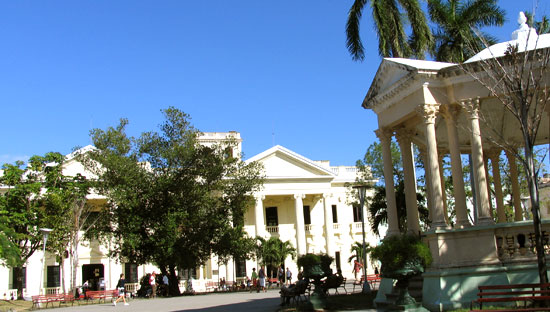
A place worthy of being discovered in the Cuban capital Havana Vieja. There you will find the most important historic buildings in Cuba. We begin our tour in Plaza de Armas, the oldest square in Havana, which originally housed the central market of the city.
At his side will find the City Museum, located in the Palace of the Captains General. It is an eighteenth century baroque building that once hosted the nobles, governors and other leaders for two centuries, was restored and converted into a museum where they walk through the history of Havana.
And north of the Square will see the Palacio of Segundo Cabo or the Administration. His style is neoclassical, and it highlights the limestone and the arcade. In its day was the residence of the second authority in the island, and also became the headquarters of the Post, the Senate and the High Court of Justice. Another interesting palace close to the Cape is the second Earl of Santovenia, now a beautiful hotel.

Leaving now the Plaza de Armas to the street Oficios find Bishop’s House, Museum Numismatic coins where guard, notes and historical and commemorative medals of different points of the globe. Also find nearby House of Arabic, one of the oldest in the city where you currently find a restaurant.
Onto Baratillo go now, to encounter the House of Comedy, building that houses one of the oldest theaters in the country of Cuba. Already in the corner of the O’Reilly found Templete building dating from the nineteenth century and whose style is neoclassical. Another particularity of the place is that the same point in the first mass was held at the arrival of the Spaniards during the colonization of the island.
Templete see next to the Castle of the Royal Force, the first of the fortresses built in the city, which was built between the years 1538 and 1544, and where is the Museo de Armas. This museum offers the enjoyment of works of Cuban artists and local ceramics.
Returning to the area of the Plaza de Armas we find the Cathedral of Havana, baroque temple whose construction began in 1748 and was completed after a stoppage of the works in 1777. Within the same altar with an outstanding work of exquisite gold work, as well as fresh Perovani and marble tabernacle. Another interesting element of it is his main campaign, founded in Spain and seven tons.
Opposite the cathedral, located in the square which gives the name, we find the Palacio de los Condes de Bayonne, also called Casa de Don Luis Chacón. There currently is located the Museum of Colonial Art, where we see an extensive collection of porcelain, stained glass and period furniture. Experimental Printmaking Workshop in Havana is very near there, leaving the Museo de Arte Colonial on the right. This workshop is located in the Casa del Marqués de Arcos, which dates from 1741.
We will now stop, inside the Casa del Marques de Aguas Claras, in whose courtyard is located the restaurant El Patio, a large entrance portico and a beauty in the entire building of the most notable of Cuba. Dates from the eighteenth century, and its broad patio, the windows and coffered observed while taking a snack we will stay there very pleasant.
Continue our march now going to the left of the cathedral, where we find the Casa del Conde Lombillo, the eighteenth century and which houses the Museum of Education, which explains in detail the literacy campaign that followed the Revolution.
La Casa del Conde is one of the reunion of the buildings described in the book ‘The Age of Enlightenment’ of the Cuban writer Alejo Carpentier. This is a nineteenth century building which has recently been restored. Of its interior is its most remarkable staircase and a courtyard, while the exterior balconies are also of interest.
And before leaving the vicinity of the port, and after the appetizer that had previously enjoyed in the House of the Marquis of Aguas Claras, stop playing again. This time for lunch at the Bodeguita del Medio, one of the most famous restaurants of Cuba. Despite his fame, the style of it is simple but the food is good and should not be left to try their mojitos to the desktop, one of the most typical drinks of the country.
And now depart for the nearby port, where to find one of the oldest houses in Havana, in Mudejar style. Located in the Plaza Vieja, which are also notable Ambos Mundos Hotel, Casa de Esteban Portia or the Casa de los Condes de Jaruco, which is headquarters of the Fund of Cultural Assets and one of the best preserved houses from the old the island. The interior of this house shows and find an inner courtyard that is worth a visit. Finally, the house of the Sisters Cárdenas we offer various visual presentations and the Convent of Santa Ana to see us leave the fortress of the early seventeenth century.
Abandoning the Old Town Square while not having visited the Old School El Salvador neoclassical find a street address in Cuba Church of the Holy Spirit, one of the oldest in Havana, and the Convento de Santa Clara, the first religious convent founded in Cuba.

For all this and more while exploring stroll through every street and every building we see, Havana Vieja us the colonial atmosphere with a detail that few places in American can admire. There are so many nuances to discover for oneself in old Havana, there is no one to let him have the books, is a place to be visited and enjoyed.
Leave a Reply
You must be logged in to post a comment.

Recent Comments